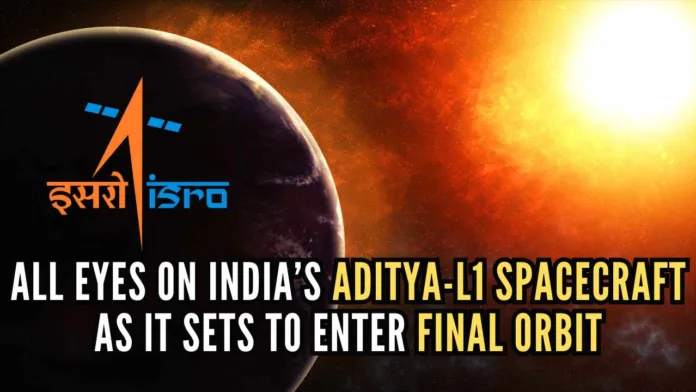
A milestone in India’s space journey as Aditya-L1 nears its destination
The Indian Space Research Organisation (ISRO) will perform the final manoeuvre today (January 6) to inject the Aditya-L1 spacecraft – the first space-based Indian observatory to study the Sun – into its final destination orbit, some 1.5 million kilometers from the Earth.
According to ISRO officials, the spacecraft will be placed in a halo orbit around Lagrange point 1 (L1) of the Sun-Earth system, about 1.5 million km from the Earth. The L1 point is about one percent of the total distance between the Earth and the Sun.
A satellite in a halo orbit around the L1 point has the major advantage of continuously viewing the Sun without any occultations/ eclipses, they said, adding, this will provide a greater advantage in observing solar activities and its effect on space weather in real-time.
“This manoeuvre (at around 4:00 pm on Saturday) will bind the Aditya-L1 to a halo orbit around L1. If we don’t do this, there is a possibility that it will continue its journey, maybe towards the Sun,” an ISRO official told media on Friday.
The Polar Satellite Launch Vehicle (PSLV-C57) launched the Aditya-L1 spacecraft from the second launch pad of Satish Dhawan Space Centre (SDSC), Sriharikota, on September 2, 2023. After a flight duration of 63 minutes and 20 seconds, it was successfully injected into an elliptical orbit of 235×19500 km around the Earth.
Aditya-L1 began collecting scientific data en route to observe the Sun.
The sensors of the Supra Thermal & Energetic Particle Spectrometer (STEPS) instrument, a part of the Aditya Solar Wind Particle Experiment (ASPEX) payload, have begun the collection of scientific data, said Indian Space Research Organisation (ISRO).
Developed by the Physical Research Laboratory (PRL) with the support of the Space Application Centre (SAC) in Ahmedabad, the STEPS instrument has begun measuring supra-thermal and energetic ions and electrons at distances greater than 50,000 km from Earth.
This data helps scientists analyze the behavior of particles surrounding the Earth.
For all the latest updates, download PGurus App.











Great achievement for the ISRO scientists who are finding wings under this BJP rule